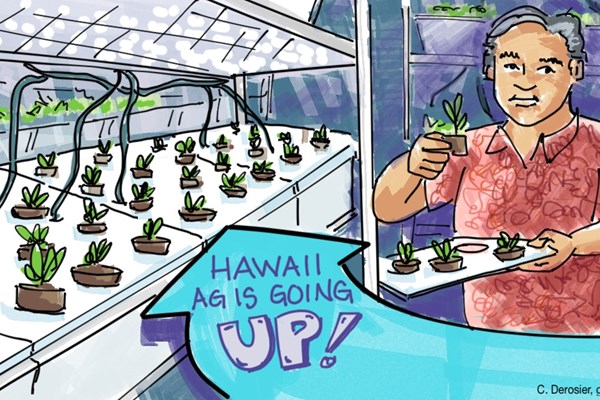Lessons of the pandemic, one year later: Kerry Kakazu, MetroGrow Hawaii
Aug 30, 2021

In the early weeks of the COVID-19 pandemic, Ulupono Initiative launched an award-winning weekly story series spotlighting Hawaii farmers, ranchers and other food producers as they adapted to the sudden disruption to Hawaii’s food distribution network. In July last year, we spoke with Kerry Kakazu, founder of MetroGrow Hawaii, the state’s first indoor vertical farm. Based in Kakaako, MetroGrow Hawaii and its team specialize in hydroponic and aeroponic growing methods to produce a variety of leafy greens.
We recently checked back in with Kakazu to see how he and MetroGrow were doing.
Have your sales recovered to pre-pandemic levels? If not, what percentage are they down from pre-pandemic levels?
I'd say we are still down about 35%. Our production capabilities are fine, but we still need more customers to get to profitability. Prior to the pandemic, we were servicing multiple restaurant accounts and had just moved into this larger space here in Kakaako. However, when some restaurants closed and others adjusted their menus to create more takeout options, we, too, had to pivot by increasing online sales and focusing more on growing leafy greens and fewer garnishes.
Has your perspective shifted since we spoke with you last year?
I think the demand for vertical-farming produce can continue to increase and we will continue to grow, but scaling up will be necessary to grow commodity food crops profitably.
Vertical farming is increasing globally as more people recognize the opportunity to increase food production in light of unpredictable weather events and decreases in land and water availability. We need more local support of alternative technologies for agriculture to improve our food self-sufficiency.
Since our system doesn’t rely on actual land to grow produce, it is a perfect option for growing food in urban and city areas. And the systems are adjustable to fit the production needs, meaning individual to family to larger-scale operations are all possible using hydroponic and aeroponic methods. The demand for locally produced food is rising and the public is aware of how agriculture fits into the local economy. Through processes such as aeroponics, we hope to change the way people think about agriculture. By setting an example of a successful alternative farming operation, we hope to demonstrate that growing your own food is possible without agricultural land and inspire others to take part.
Because we’re growing indoors, we utilize full-spectrum LED lighting to provide around-the-clock “sunshine” for photosynthesis. We also use a closed-loop watering system, so water usage is drastically reduced.
If you could send a message back through time, what would you tell yourself at the start of the pandemic — in March 2020 — to help your operation make it through?
Diversify your product mix and customer base.
Last year, we started attending the Honolulu Farmers Market, which has increased our sales. We also added value-added products (which include) growing kits and foods made with our products. Consumer sales have helped expand our customer base but require more effort than restaurant sales.
We currently produce over a dozen different microgreens such as arugula, kale and cilantro; specialty greens like baby watercress and basil; and various types of shoots. We also have three different varieties of lettuce.
What is most needed now to succeed?
Fully open restaurants, one more round of government grants and loans, and investment in agriculture tech like vertical farming.
Anything else you’d like to add?
Because we’re growing indoors, we utilize full-spectrum LED lighting to provide around-the-clock “sunshine” for photosynthesis. We also use a closed-loop watering system, so water usage is drastically reduced.
Our aeroponics system includes a mineral fertilizer, so we can’t be certified organic. However, we only use a fraction of the mineral fertilizer traditional farms use, and because there is no run-off into the soil, our impact on agricultural land is zero. Because we operate entirely indoors, we also don’t use any chemical pesticides. So in some ways, we have a cleaner approach than organic farms.
Coming soon, we plan to expand our inventory of hydroponic supplies for purchase, including do-it-yourself microgreen kits good for growing fresh and healthy microgreens at home with limited space. We hope this will help spark more interest in local food production not only with hobbyists, but also for school children learning more about how plants grow. It’s always fun to have a science project you can safely eat when you’re done!
For more information about MetroGrow Hawaii, visit www.metrogrowhawaii.com or stop by the location on Kawaiahao Street.
Learn more about MetroGrow in this recent TV episode of Living808 on KHON2 >>

